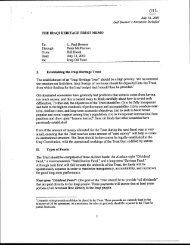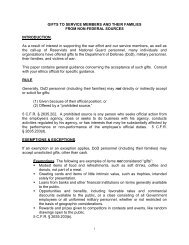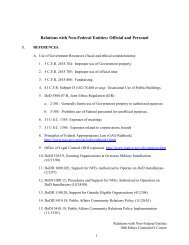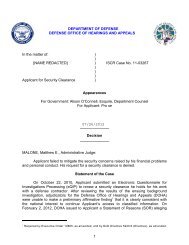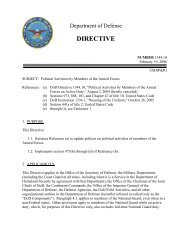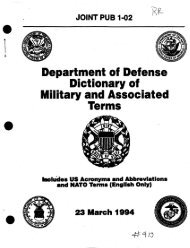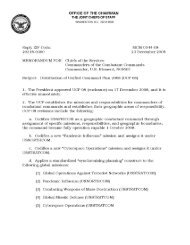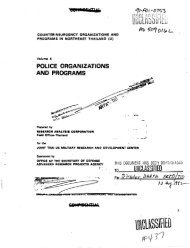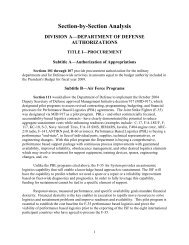dod tactical herbicide sites - United States Department of Defense
dod tactical herbicide sites - United States Department of Defense
dod tactical herbicide sites - United States Department of Defense
You also want an ePaper? Increase the reach of your titles
YUMPU automatically turns print PDFs into web optimized ePapers that Google loves.
e continually maintained while the Air Force sought a final solution for the disposition<strong>of</strong> the surplus.After 1970, the Herbicide Orange inventory at NCBC was augmented by receipt <strong>of</strong>shipment <strong>of</strong> surplus Herbicide Orange that had been in temporary storage at Eglin AirForce Base, Florida, and by receipt <strong>of</strong> shipment <strong>of</strong> surplus Herbicide Pink (n-butyl 2,4,5-T) that had been in storage at Kelly Air Force Base, Texas. The research efforts todevelop a viable option for the disposal <strong>of</strong> Herbicide Orange expended approximately180 drums <strong>of</strong> <strong>herbicide</strong>, leaving the inventory in April 1977 at 15,470 drums (850,850gallons). Immediately after the US Environmental Protection Agency issued the permitfor the at-sea incineration <strong>of</strong> Herbicide Orange, Operation PACER HO (pacer an AirForce term for movement, and HO for Herbicide Orange) was implemented at NCBC on29 April 1977.Assessment: Operation PACER HO required the dedication and coordination <strong>of</strong>military and civilian personnel from numerous state and federal agencies and from themilitary installations in Texas, Mississippi, Alabama, Florida, Ohio, Hawaii, Utah,Georgia, Oklahoma, and California. The Programming Plan detailed requirements for (1)de-drumming operations at Gulfport, Mississippi and Johnston Island; (2) environmentalmonitoring at Gulfport and Johnston Island; and (3) disposal by at-sea incineration in aremote area <strong>of</strong>f Johnston Island. The plan also included personnel requirements, medicaland environmental surveillance, emergency protocols, public relations coordination, andtechnical guidance for all <strong>of</strong> the engineering and transportation requirements. The activeduty military at the AFLC Occupational and Environmental Laboratory, Brooks AirForce Base, Texas played key roles in the oversight <strong>of</strong> all activities during OperationPACER HO. The physical operation for PACER HO commenced on 2 May 1977 atNCBC. The schedule called for all actions to be completed at Gulfport within 38 days atwhich time the operation would shift to Johnston Island, with final activities including atseaincineration to be completed by day 123 (5 September 1977).The need for Operation PACER HO personnel for the NCBC portion <strong>of</strong> the operationwas met by issuing a call for active duty military volunteers from the Air Force LogisticsCommand’s five Combat Logistics Support Squadrons (CLSS). More than 200 menvolunteered from Robins Air Force Base Georgia (the 2955 th CLSS), Hill Air Force Base,Utah (the 2952 nd CLSS), Kelly Air Force Base, Texas (the 2954 th CLSS), Tinker AirForce Base, Oklahoma (2953 rd CLSS) and McClellan Air Force Base, California (2951 stCLSS). Additional civilian and military personnel came from Andrews Air Force Base,Maryland, Wright-Patterson Air Force Base, Ohio, and the <strong>United</strong> <strong>States</strong> Air ForceAcademy, Colorado.The members <strong>of</strong> CLSS teams were responsible for carrying out all phases <strong>of</strong> PACER HOincluding empting drums, loading tank cars, pumping the <strong>herbicide</strong> onboard the M/TVulcanus at the Gulfport Outport Dock, and crushing and stacking the emptied 55-gallondrums. The uniform <strong>of</strong> the day for all CLSS members in the processing <strong>of</strong> the <strong>herbicide</strong>included protective clothing, masks with respirators and goggles, and personalmonitoring devices that were checked at regular intervals. The medical staff from the72



